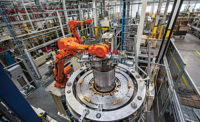Automated assembly lines have been the backbone of the automotive industry for decades. Robots are widely used to rivet and weld car bodies. But, in the aerospace sector, automation is more elusive when it comes to building fuselages and wings for commercial aircraft.
Traditionally, the process of producing airframes is a manual task that uses fixed gantries and other types of large monument machines. The intricate process of drilling, countersinking and riveting tubular structures has proven difficult to automate.
That’s because there are several key differences between the auto industry and the commercial aerospace sector. Tolerances are much higher in aerospace applications, and the average subassembly is larger and heavier. Production volumes in aerospace are also much smaller than in the auto industry, while the life expectancy of the products being produced is much higher.
Boeing engineers have struggled to adapt robots for fuselage assembly tasks. After investing millions of dollars to automate its 777X wide-body jetliner production line, the aerospace giant has just pulled the plug on the project. Boeing will use humans to manually insert and tighten fasteners (robots will still do the drilling) because they’re proven to be “more reliable, requiring…less rework.”
“Automation certainly has its place, but it’s not necessarily a guaranteed cost reducer or efficiency improver in the aerospace industry,” says Richard Aboulafia, vice president of analysis at the Teal Group. “It all depends on volume. Automated assembly lines make sense for popular aircraft that have large backlogs.”
For instance, Airbus has orders for more than 6,000 copies of its A320 single-aisle jetliner. That’s one reason why it appears to be going in the opposite direction of Boeing when it comes to implementing automation.
Airbus recently unveiled an automated fuselage assembly line in Hamburg, Germany, that uses a variety of robots. The machines, housed in a building dubbed Hangar 245, are used to produce variants of its popular A320. It serves as a showcase for what Airbus believes is the future of aircraft assembly.
“With a special focus on manufacturing longer sections for the A321LR, the new facility features 20 robots, a new logistics concept, automated positioning by laser measurement and a digital data acquisition system,” says Michael Schoellhorn, CEO of Airbus. “These will further support [our] drive to improve both quality and efficiency, while bringing an enhanced level of digitalization to [our] production system.
“By embracing some of the latest technologies and processes, [we have] begun [our] journey to set new standards in [aircraft] production,” claims Schoellhorn.
The automated system will enable Airbus to increase productivity by 20 percent to 30 percent. For the initial section assembly, Airbus engineers rely on a modular, lightweight modular system produced by MTM Robotics. Flextrack consists of eight robots that drill and countersink 1,100 to 2,400 holes per longitudinal joint. The robots travel on a vacuum rail that’s attached to curved fuselage sections.
The next production step features 12 seven-axis robots supplied by KUKA. They are used to attach the center and aft fuselage sections with the tail. The robots drill, countersink, seal and insert 3,000 rivets per orbital pass.
Besides the use of robots, Airbus is also harnessing advanced technology for material handling applications to improve ergonomics and shorten lead times. The Hamburg factory features separate logistics and production levels, demand-oriented material replenishment and automated guided vehicles.
An overhead monorail conveyor system transports fuselage shells, while laser measurement tools positon the shells within 0.2 millimeter accuracy. Airbus engineers also created a digital twin of the state-of-the-art production line, which collects data for analysis via multiple sensors.



